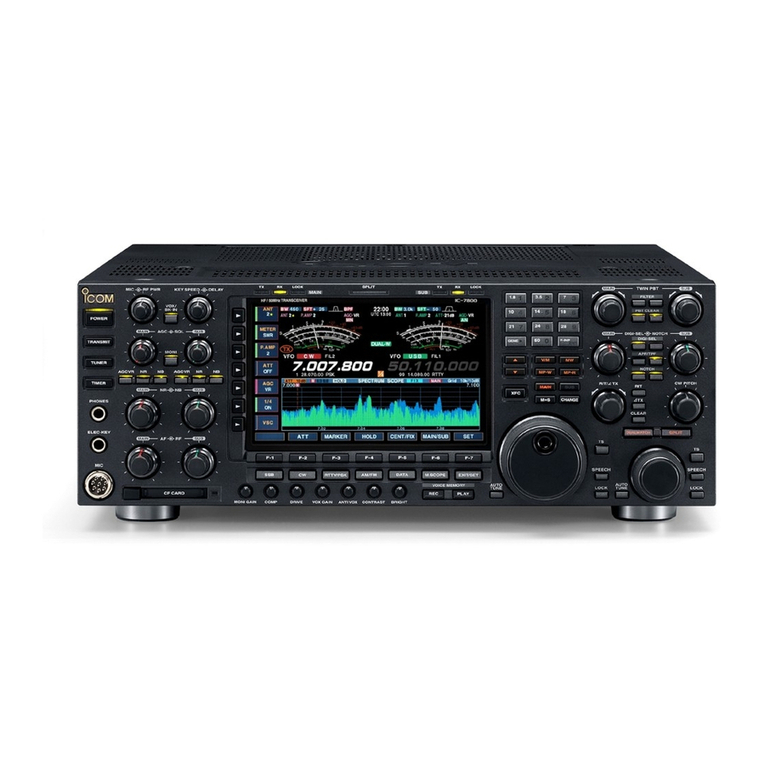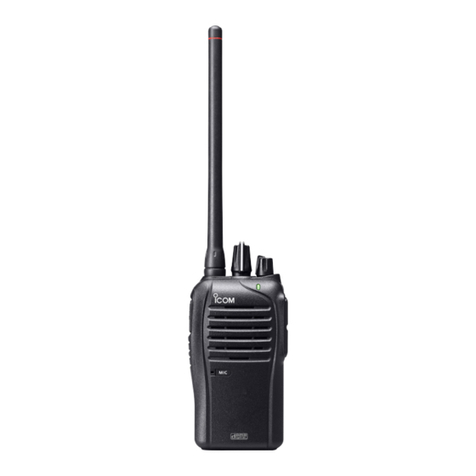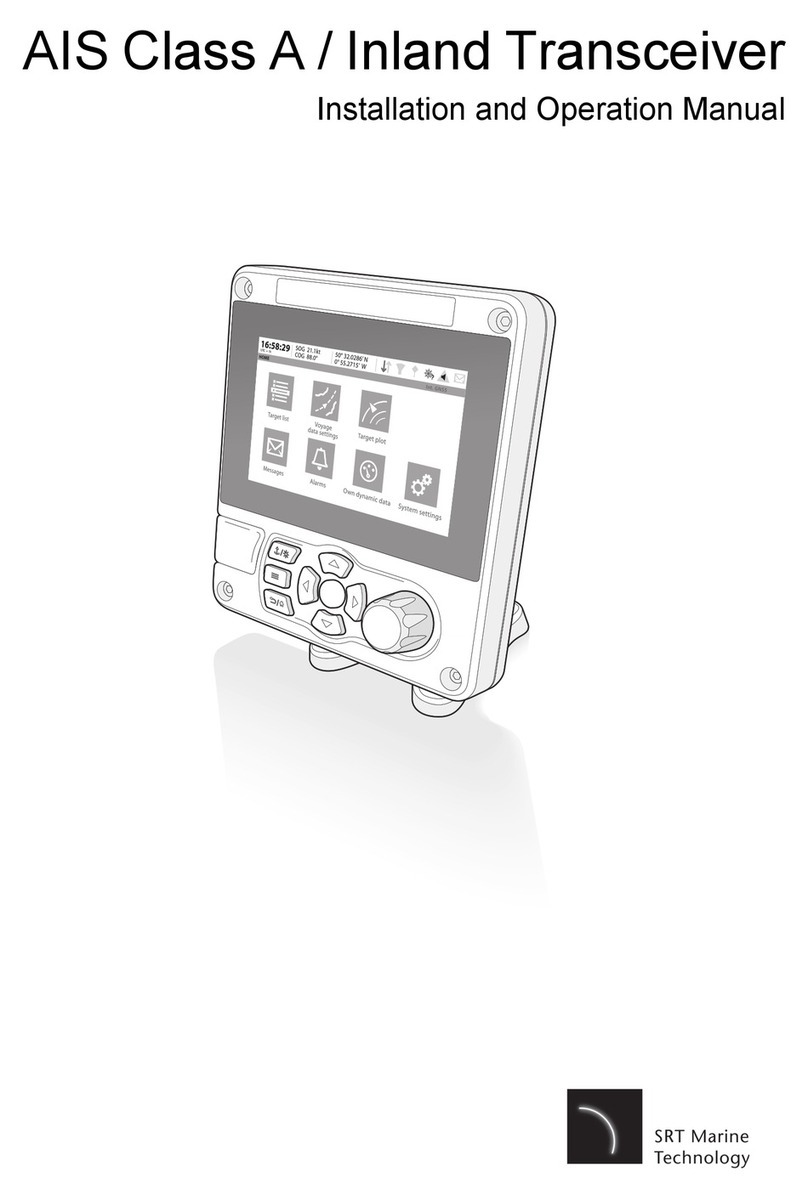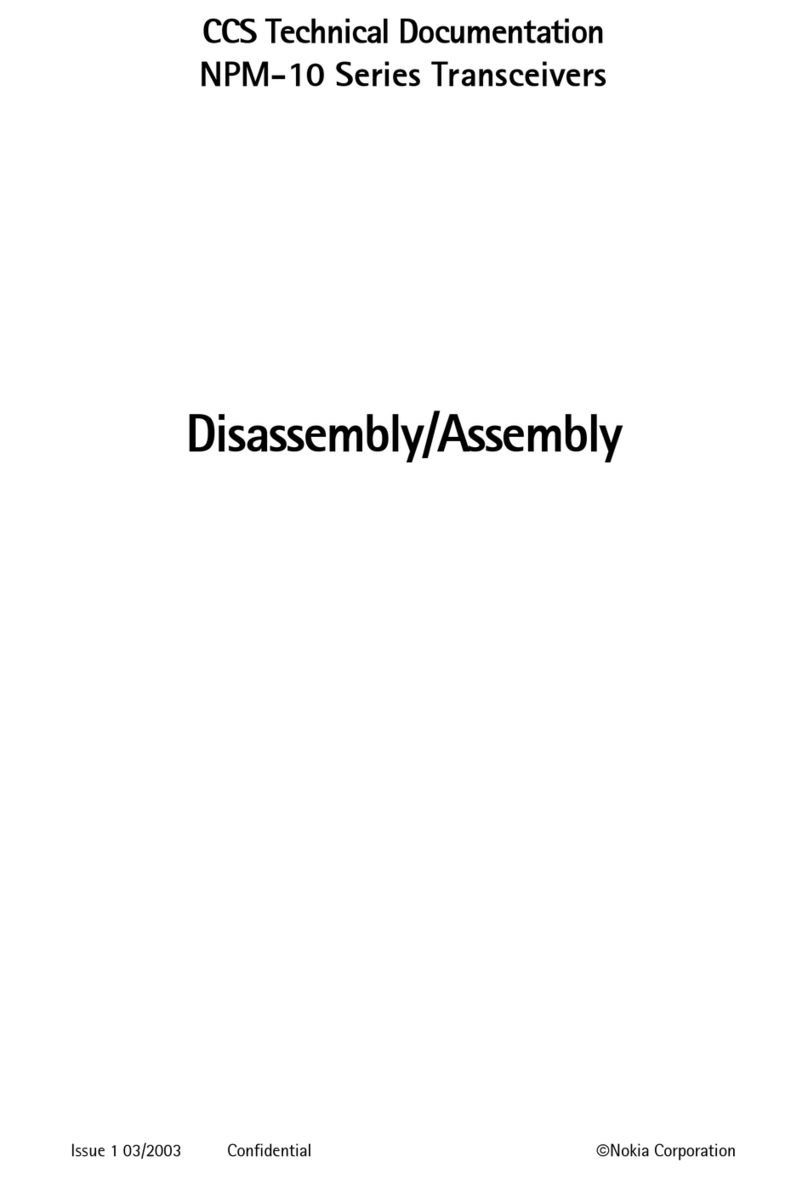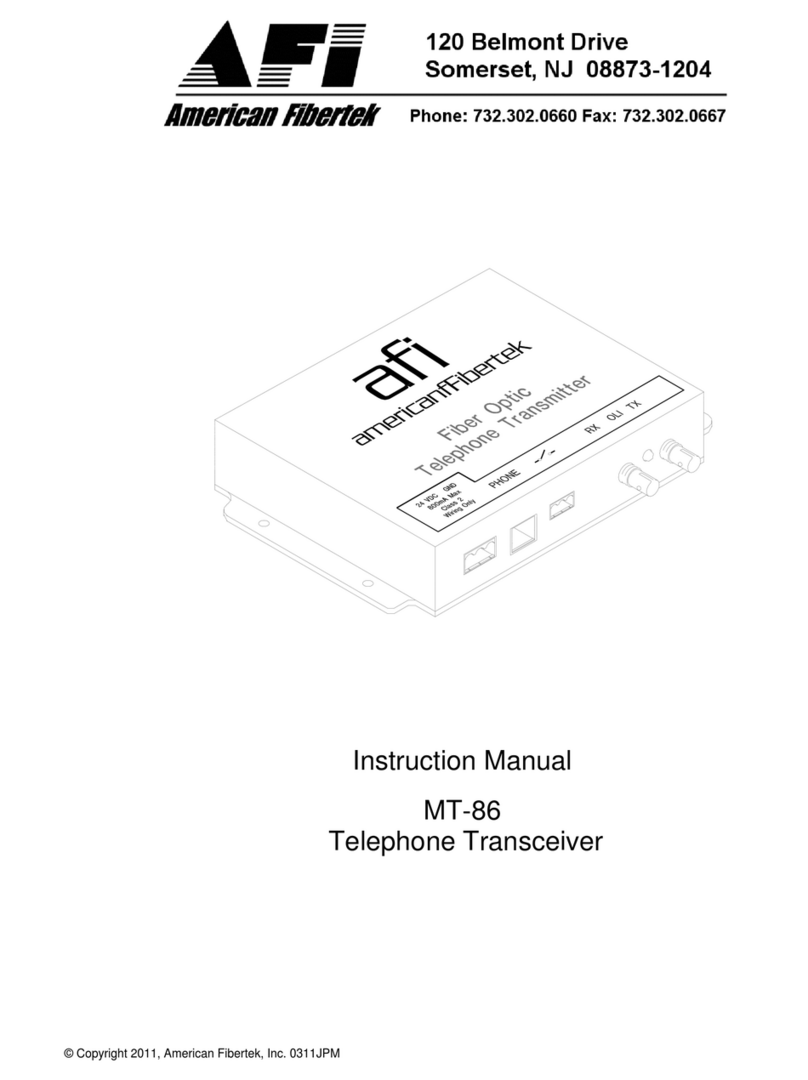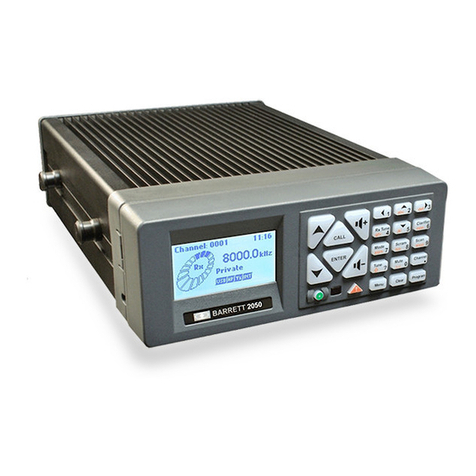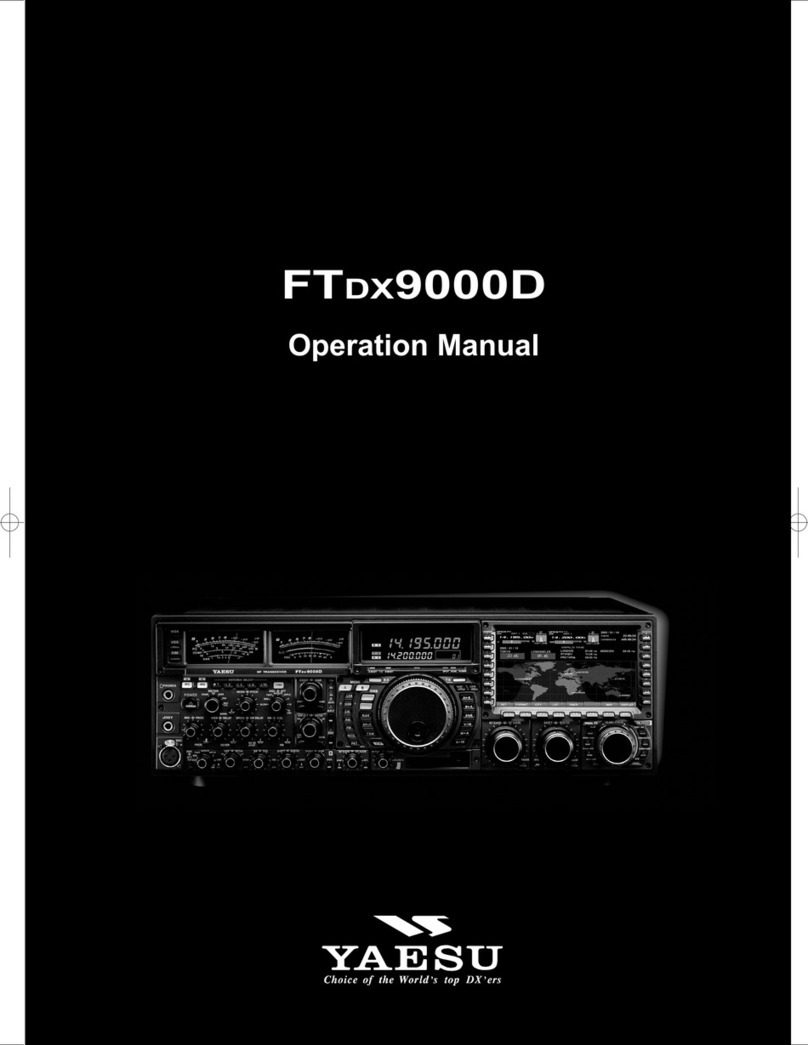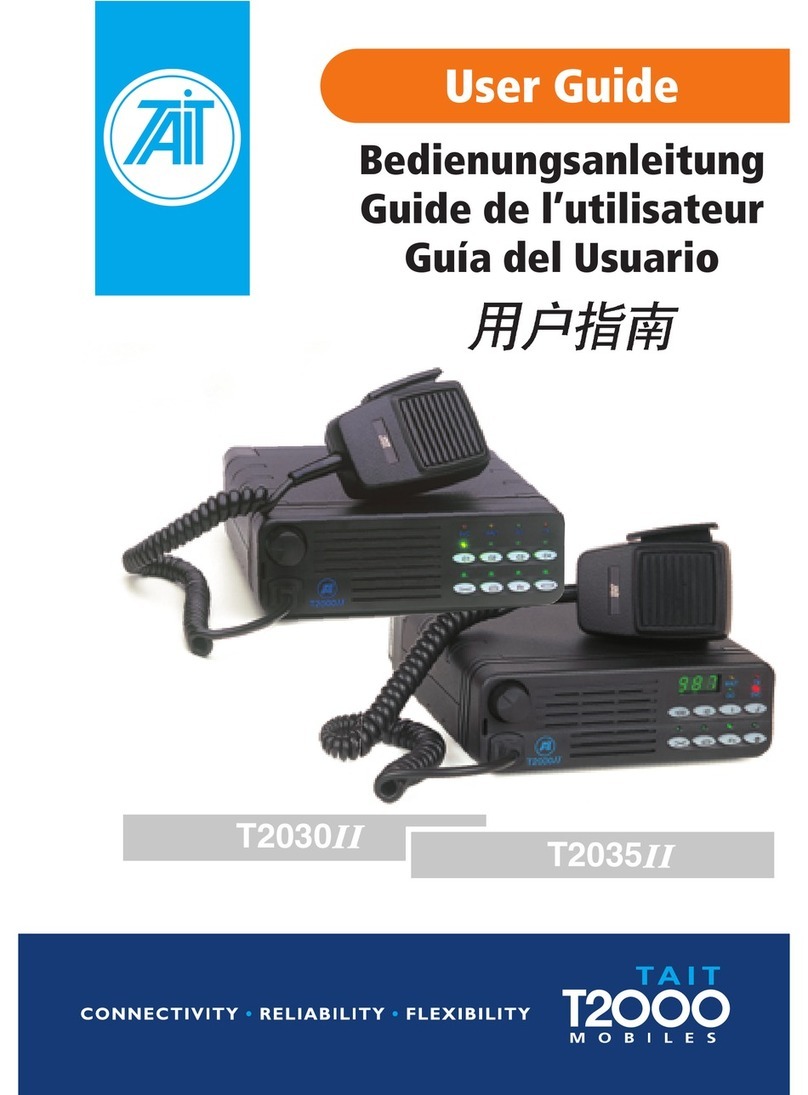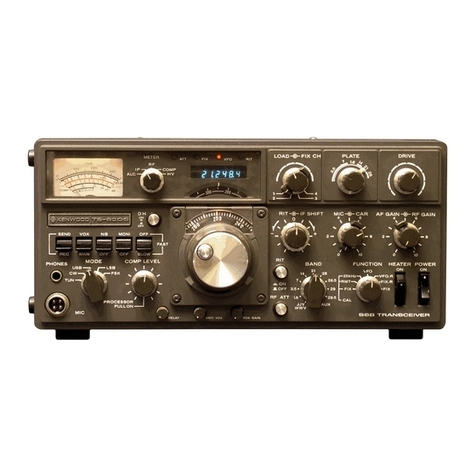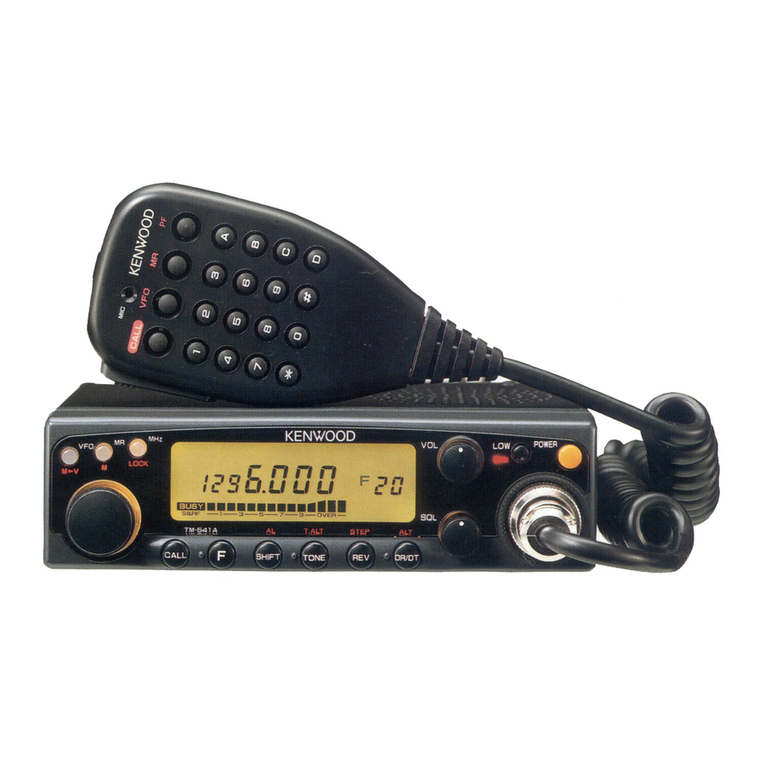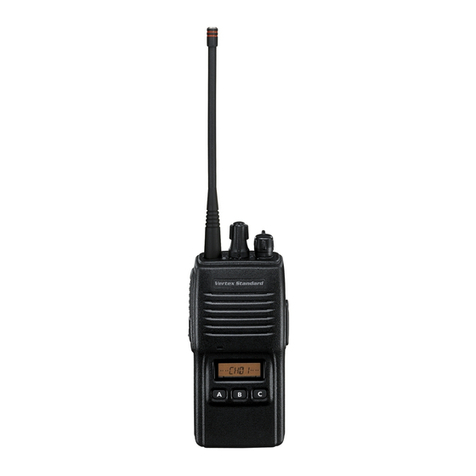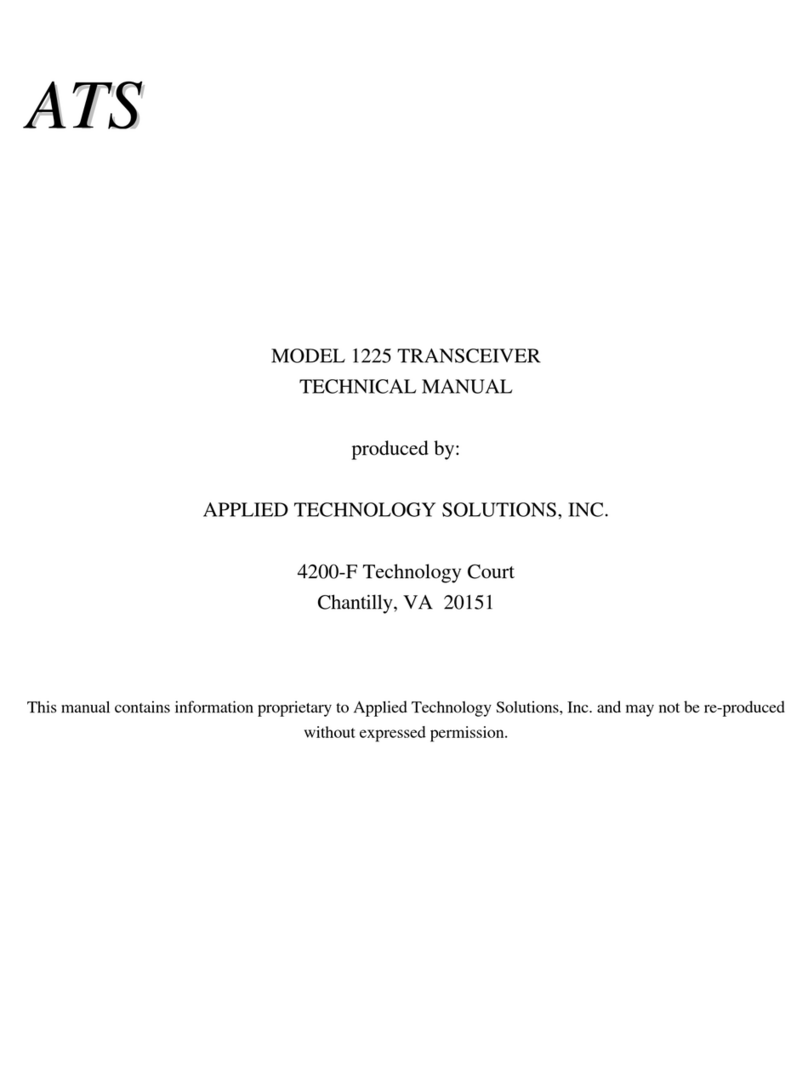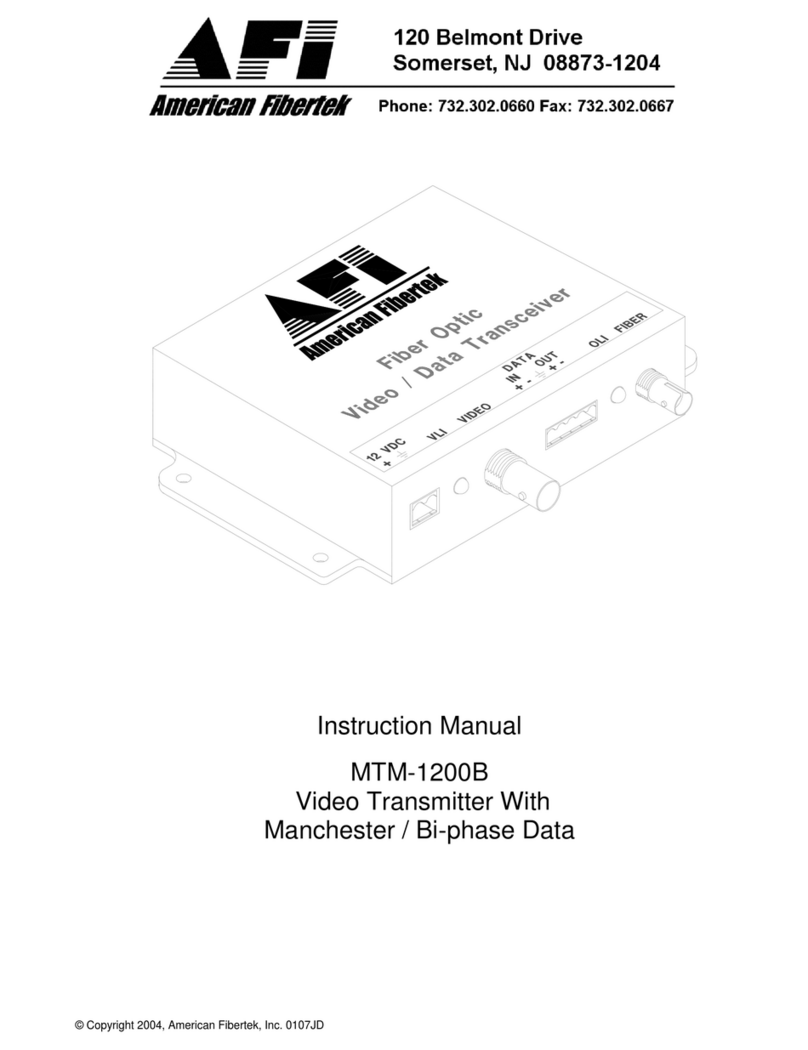Icom IC-M90 User manual

INSTRUCTION MANUAL
iM90
VHF MARINE TRANSCEIVER
This device complies with Part 15 of the FCC
Rules. Operation is subject to the condition that
this device does not cause harmful interference.

i
SAFETY TRAINING INFORMATION
Your Icom radio generates RF electromagnetic energy dur-
ing transmit mode.
This radio has been evaluated for compliance at the dis-
tance of 2.5 cm (1 inch) with the FCC RF exposure limits
for “Occupational Use Only”. In addition, your Icom radio
complies with the following Standards and Guidelines with
regard to RF energy and electromagnetic energy levels and
evaluation of such levels for exposure to humans:
• FCC OET Bulletin 65 Edition 97-01 Supplement C, Evaluating Compli-
ance with FCC Guidelines for Human Exposure to Radio Frequency
Electromagnetic Fields.
• American National Standards Institute (C95.1-1992), IEEE Standard
for Safety Levels with Respect to Human Exposure to Radio Frequency
Electromagnetic Fields, 3 kHz to 300 GHz.
• American National Standards Institute (C95.3-1992), IEEE Recom-
mended Practice for the Measurement of Potentially Hazardous Electro-
magnetic Fields– RF and Microwave.
• The following accessories are authorized for use with this product. Use of
accessories other than those specified may result in RF exposure levels
exceeding the FCC requirements for wireless RF exposure.; Belt Clip
(MB-86/103), Rechargeable Ni-Cd Battery Pack (BP-224, BP-225), Li-ion
Battery Pack (BP-252) and Alkaline Battery Case (BP-223).
To ensure that your expose to RF electromagnetic en-
ergy is within the FCC allowable limits for occupational
use, always adhere to the following guidelines:
• DO NOT operate the radio without a proper antenna attached, as this
may damaged the radio and may to exceed FCC RF exposure limits. A
proper antenna is the antenna supplied with this radio by the manufac-
turer or an antenna specifically authorized by the manufacturer for use
with this radio.
• DO NOT transmit for more than 50% of total radio use time (“50% duty
cycle”). Transmitting more than 50% of the time can cause FCC RF expo-
sure compliance requirements to be exceeded. The radio is transmitting
when the “transmit/receive indicator” lights red. You can cause the radio
to transmit by pressing the “PTT” switch.
• ALWAYS keep the antenna at least 2.5 cm (1 inch) away from the body
when transmitting and only use the Icom belt-clips which are listed on
p. 33 when attaching the radio to your belt, etc., to ensure FCC RF
exposure compliance requirements are not exceeded. To provide the
recipients of your transmission the best sound quality, hold the radio in
an almost vertical position at least 5 cm (2 inches) from your mouth, the
microphone is located next to the speaker, so you shoud “talk into the
speaker”.
The information listed above provides the user with the information needed
to make him or her aware of RF exposure, and what to do to assure that this
radio operates within FCC RF exposure limits.
Electromagnetic Interference/Compatibility
During transmissions, your Icom radio generates RF energy that can possibly
cause interference with other devices or systems. To avoid such interference,
turn off the radio in areas where signs are posted to do so. DO NOT operate
the transmitter in areas that are sensitive to electromagnetic radiation such as
hospitals, aircraft, and blasting sites.
CAUTION
WARNING

ii
IN CASE OF EMERGENCY
If your vessel requires assistance, contact other vessels and
the Coast Guard by sending a distress call on Channel 16.
❍ USING CHANNEL 16
DISTRESS CALL PROCEDURE
1. “MAYDAY MAYDAY MAYDAY.”
2. “THIS IS ...........................” (name of vessel)
3. Your call sign or other indication of the ves-
sel.
4. “LOCATED AT ..................... ” (your position)
5. The nature of the distress and assistance
required.
6. Any other information which might facilitate
the rescue.
RECOMMENDATION
CLEAN THE TRANSCEIVER THOROUGHLY WITH FRESH
WATER after exposure to saltwater, and dry it before opera-
tion. Otherwise, the transceiver’s keys, switches and control-
lers may become inoperable due to salt crystallization.
NOTE: DO NOT wash the transceiver in water if there is any
reason to suspect the waterproofing may not be effective.
For example, in cases where the battery pack rubber seal is
damaged, the transceiver/battery pack is cracked or broken,
or has been dropped, or when the battery pack is detached
from the transceiver.
MIC
/SP

FOREWORD
Thank you for purchasing this Icom radio. The IC-M90 VHF MA-
RINE TRANSCEIVER is designed and built with Icom’s state
of the art technology and craftsmanship. With proper care this
product should provide you with years of trouble-free operation.
IMPORTANT
READ ALL INSTRUCTIONS carefully and com-
pletely before using the transceiver.
SAVE THIS INSTRUCTION MANUAL—This
instruction manual contains important operating instructions
for the IC-M90.
EXPLICIT DEFINITIONS
FEATURES
☞Submersible construction
Built tough to withstand the punishing marine environ-
ment, the transceiver’s submersible construction meets
IPX7* requirements for waterproof protection (1 meter;
3.3 ft depth for 30 min.).
In addition to, the speaker grill adopts a new structure
which drains water or seawater easily.
* Only when the battery pack and flexible antenna are attached.
☞Dualwatch and tri-watch functions
Convenient functions which allow you to monitor the dis-
tress channel (Ch 16) while receiving one other channel
of your choice (dualwatch), or while receiving one other
channel of your choice and the call channle (Ch 09) (tri-
watch). See p. 14 for details.
☞Large, easy-to-read LCD
With dimensions of 19(H) × 35(W) mm; 3⁄4(H) × 13⁄8(W)
inch, the transceiver’s function display is easy to read and
shows operating conditions at a glance. Backlighting and
contrast can be adjusted to suit your preferences.
☞Simple operation
6 large buttons on the front panel provide user-friendly
operation. The independent volume and channel buttons
are located on the front panel for convenient one-handed
operation.
iii
WORD DEFINITION
RWARNING
CAUTION
NOTE
Personal injury, fire hazard or electric shock
may occur.
If disregarded, inconvenience only. No risk
of personal injury, fire or electric shock.
Equipment damage may occur.

iv
PRECAUTION
RWARNING! NEVER connect the transceiver to an
AC outlet. This may pose a fire hazard or result in an electric
shock.
RWARNING! NEVER hold the transceiver so that
the antenna is closer than 2.5 cm (1 inch) from exposed
parts of the body, especially the face or eyes, while transmit-
ting. The transceiver will perform best if the microphone is
5 to 10 cm (2 to 4 inches) away from the lips and the trans-
ceiver is vertical.
NEVER connect the transceiver to a power source other
than the BP-223, BP-224, BP-225, or BP-252. Such a con-
nection will ruin the transceiver.
DO NOT use or place the transceiver in direct sunlight
or in areas with temperatures below –20°C (–4°F) or above
+60°C (+140°F): MARINE, –30°C (–22°F) or above +60°C
(+140°F): LMR.
KEEP the transceiver out of the reach of children.
KEEP the transceiver at least 0.9 meters (3.0 ft) away
from your vessel’s magnetic navigation compass.
MAKE SURE the flexible antenna and battery pack are
securely attached to the transceiver, and that the antenna
and battery pack are dry before attachment. Exposing the in-
side of the transceiver to water will result in serious damage
to the transceiver.
BE CAREFUL! The transceiver meets IPX7* require-
ments for waterproof protection. However, once the trans-
ceiver has been dropped, waterproof protection cannot be
guaranteed because of possible damage to the transceiver's
case or the waterproof seal.
* Only when the battery pack and flexible antenna are attached.
Icom optional equipment are designed for optimal perform-
ance when used with this transceiver. We are not respon-
sible for the transceiver being damaged or any accident
caused when using non-Icom optional equipment.
For U.S.A. only
CAUTION: Changes or modifications to this device, not
expressly approved by Icom Inc., could void your authority to
operate this device under FCC regulations.
Icom, Icom Inc. and the Icom logo are registered trademarks of Icom Incor-
porated (Japan) in Japan, the United States, the United Kingdom, Germany,
France, Spain, Russia and/or other countries.

v
SAFETY TRAINING INFORMATION ............................................... i
IN CASE OF EMERGENCY .......................................................... ii
RECOMMENDATION ..................................................................... ii
FOREWORD ................................................................................. iii
IMPORTANT .................................................................................. iii
EXPLICIT DEFINITIONS ............................................................... iii
FEATURES .................................................................................... iii
PRECAUTION ............................................................................... iv
TABLE OF CONTENTS .................................................................. v
1 OPERATING RULES ................................................................. 1
2 SUPPLIED ACCESSORIES AND ATTACHMENTS............... 2–3
■Supplied accessories .............................................................. 2
■Attachments ............................................................................ 2
3 PANEL DESCRIPTION .......................................................... 4–6
■Front, top and side panels ....................................................... 4
■Function display ..................................................................... 5
4 BASIC OPERATION ............................................................ 7–11
■Channel selection ................................................................... 7
■Receiving and transmitting ..................................................... 9
■Call channel programming ................................................... 10
■Lock function ........................................................................ 10
■Signal strength indicator function ......................................... 10
■Monitor function .................................................................... 10
■Adjusting the squelch level ................................................... 11
■Automatic backlighting .......................................................... 11
■Voice scrambler operation .................................................... 11
5 SCAN OPERATION ........................................................... 12–13
■Scan types ............................................................................ 12
■Setting tag channels ............................................................. 13
■Starting a scan ..................................................................... 13
6 DUALWATCH/TRI-WATCH ...................................................... 14
■Description ........................................................................... 14
■Operation .............................................................................. 14
7 LAND CHANNEL OPERATION .............................................. 15
■LAND channel group ............................................................ 15
■CTCSS and DTCS display ................................................... 15
■VOX function ......................................................................... 15
8 SET MODE ........................................................................ 16–21
■SET mode programming ...................................................... 16
■SET mode items ................................................................... 17
9 BATTERY CHARGING ...................................................... 22–25
■Battery charging ................................................................... 22
■Battery cautions ................................................................... 22
■Optional battery case ........................................................... 23
■Optional battery chargers ..................................................... 24
10 OPTIONAL SWIVEL BELT CLIP ............................................ 26
■MB-86 contents .................................................................... 26
■Attachment ........................................................................... 26
■Detachment .......................................................................... 26
11 OPTIONAL SPEAKER-MICROPHONE .................................. 27
■Descriptions .......................................................................... 27
■Attachment ........................................................................... 27
12 TROUBLESHOOTING ............................................................. 28
13 VHF MARINE CHANNEL LIST ............................................... 29
14 SPECIFICATIONS ................................................................... 30
15 QUICK REFERENCE .............................................................. 31
16 OPTIONS ................................................................................ 33
TABLE OF CONTENTS

1
1
OPERATING RULES
D Priorities
• Read all rules and regulations pertaining to priorities and
keep an up-to-date copy handy. Safety and distress calls
take priority over all others.
• You must monitor Channel 16 when you are not operating
on another channel.
• False or fraudulent distress calls are prohibited under law.
D Privacy
• Information overheard but not intended for you cannot law-
fully be used in any way.
• Indecent or profane language is prohibited.
D Radio licenses
(1) SHIP STATION LICENSE
When your craft is equipped with a VHF FM transceiver, you
must have a current radio station license before using the
transceiver. It is unlawful to operate a ship station which is
not licensed.
Inquire through your dealer or the appropriate government
agency for a Ship-Radiotelephone license. This license
includes the call sign which is your craft’s identification for
radio purposes.
(2) OPERATOR’S LICENSE
A restricted Radiotelephone Operator Permit is the license
most often held by small vessel radio operators when a radio
is not required for safety purposes.
The Restricted Radiotelephone Operator Permit must be
posted near the transceiver or be kept with the operator.
Only a licensed radio operator may operate a transceiver.
However, non-licensed individuals may talk over a trans-
ceiver if a licensed operator starts, supervises, ends the call
and makes the necessary log entries.
A current copy of the applicable government rules and regu-
lations is only required to be on hand for vessels in which a
radio telephone is compulsory. However, even if you are not
required to have these on hand it is your responsibility to be
thoroughly acquainted with all pertinent rules and regula-
tions.
NOTE: Even though the IC-M90 is capable of operation
on VHF marine channels 3, 21, 23, 61, 64, 81, 82 and
83, according to FCC regulations these simplex channels
cannot be lawfully used by the general occupational in
USA waters.
1

2
SUPPLIED ACCESSORIES AND ATTACHMENTS
2
■Supplied accessories
The following accessories are supplied: Qty.
• Handstrap. . . . . . . . . . . . . . . . . . . . . . . . . . . . . . . . . . . . . 1
• Belt clip. . . . . . . . . . . . . . . . . . . . . . . . . . . . . . . . . . . . . . . 1
• Battery pack . . . . . . . . . . . . . . . . . . . . . . . . . . . . . . . . . . . 1
• Battery charger (with 2 screws) . . . . . . . . . . . . . . . . . . . . 1
• AC adapter . . . . . . . . . . . . . . . . . . . . . . . . . . . . . . . . . . . . 1
• Flexible antenna . . . . . . . . . . . . . . . . . . . . . . . . . . . . . . . . 1
■Attachments
DFlexible antenna
Connect the supplied flexible an-
tenna to the antenna connector.
CAUTION:
• NEVER carry the transceiver
by holding the antenna.
• Transmitting without an
antenna may damage the
transceiver.
DHandstrap
Pass the handstrap through the
loop on the top of the transceiver
as illustrated at right. Facilitates
carrying.
DBelt clip
Attach the belt clip to the transceiver as illustrated below.
MIC
/SP
Supplied screws

3
2
SUPPLIED ACCESSORIES AND ATTACHMENTS
DBattery pack
To remove the battery pack:
Turn the screw counterclockwise, then pull the battery pack
in the direction of the arrow as shown below.
To attach the battery pack:
Insert the battery pack in the IC-M90 completely, then turn
the screw clockwise.
NEVER remove or insert the battery pack when the
transceiver is wet or soiled. This may result water or dust
getting into the transceiver/battery pack and may result in
the transceiver being damaged.
NOTE: When removing or attaching the battery pack, use
a coin or flat-blade screwdriver to loosen or tighten the
bottom screw.
CAUTION:
When attaching or removing a battery pack, make sure
the rubber seal is set in the groove of the battery pack
correctly. If the seal is not neatly in the groove it may be
damaged when attaching the battery pack.
If the seal is damaged, waterproofing is not guaranteed.
OPEN
LOCK
Screw position
when removing battery
Screw position
when attaching battery
OPEN
LOCK
Make sure both the rubber seal (purple) is set to the groove
correctly and dust or else does not adhere to it.
Battery pack Battery pack
Rubber seal
Groove
Correct position Incorrect position
NOTE:
When attaching a battery pack, make sure dust or else does
not adhere to the rubber seal. If dust or else is on the seal
when attaching a battery pack, the water resistant may be
reduced.
2
NOTE: When the lock screw does not easily (feels tight),
check to ensure the battery pack is sufficiently inserted to
the transceiver. DO NOT bang or cause high impact to
the battery pack, as this may damage the battery pack/or
the transceiver.

4
PANEL DESCRIPTION
3
■Front, top and side panels
MIC
/SP
qe
r
y
t
w
i
u
o
!1
!0
qVOLUME CONTROL [VOL]
Turns power ON and adjusts the audio level.
wMICROPHONE CONNECTOR [SP MIC]
Connects the optional external microphone.
NOTE: Attach the [SP MIC] cap when the optional
speaker-microphone is not used.
eANTENNA CONNECTOR
Connects the supplied antenna.
rTRANSMIT/RECEIVE INDICATOR
Lights green while receiving a signal or when the squelch
is open; lights red while transmitting; lights orange while
the VOX function is used.
tCHANNEL/WEATHER CHANNEL SWITCH
[CH/WX•U/I/C/L]
• Selects and toggles the regular channels and weather
channel when pushed. (p. 8)
• Selects one of 4 regular channels in sequence when
pushed for 1 sec. (pgs. 8, 15)
- U.S.A., International, Canadian and Land channels are
available.
• Push to return to the condition before selecting the
channel when the priority channel or the call channel is
selected.
ySCAN SWITCH [SCAN•DUAL]
• Starts and stops normal or priority scan when pushed.
(pgs. 12, 13)
• Enters watch mode when pushed for 1 sec. (p. 14)

5
3
PANEL DESCRIPTION
uTRANSMIT POWER/LOCK SWITCH [Hi/Lo• ]
• Selects high, middle or low power when pushed. (p. 9)
• Toggles the lock function ON/OFF when pushed for
1 sec. (p. 10)
iCHANNEL 16 SWITCH [16•9]
• Selects Channel 16 when pushed. (p. 7)
• Selects call channel when pushed for 1 sec. (p. 7)
• Enters call channel write mode when the call channel is
selected and this switch is pushed for 3 sec. (p. 10)
oCHANNEL UP/DOWN SWITCHES [Y]/[Z]
• Selects an operating channel. (pgs. 7–9)
• Selects the SET mode condition of the item. (p. 16)
• Selects the SET mode item when pushed with [SQL].
(p. 16)
• Checks tag channels or changes scanning direction dur-
ing scan. (p. 13)
!0 SQUELCH SWITCH [SQL•MONI]
• Push this switch, then adjust the squelch level with
[Y]/[Z]. (p. 11)
• Manually opens the squelch for monitoring the channel
while pushed and held. (p. 10)
• While pushing this switch, turn power ON to enter the
set mode. (p. 16)
!1 PTT SWITCH [PTT]
Push and hold to transmit; release to receive.
■Function display
q SIGNAL STRENGTH INDICATOR (pgs. 10, 20)
Shows the relative signal strength while receiving signals.
w TRANSMIT POWER INDICATOR
• “LOW” appears when low power is selected.
• “MID” appears when middle power is selected.
• No indication appears when high power is selected.
e TAG CHANNEL INDICATOR (p. 13)
Appears when tag channel is selected.
r SQUELCH LEVEL INDICATOR (p. 11)
Show the squelch level.
3
q r t yw e
!4
!6
!5
u
i
o
!0
!1
!2
!3
!8
!7

6
3PANEL DESCRIPTION
t MONITOR INDICATOR (p. 10)
Appears when the monitor function is activated.
y BATTERY INDICATOR
Indicates remaining battery power.
u WEATHER CHANNEL/WEATHER ALERT INDICATORS
(p. 8)
• “WX” appears when the weather channel group is
selected.
• “WX ALT” appears when the weather alert function is
activated.
i BELL INDICATOR
Blinks when an alert tone is received.
o SCAN INDICATOR (p. 13)
“SCAN” blinks during scan.
!0 VOX INDICATOR (p. 15)
“VOX” appears when the VOX function is used.
!1 DUALWATCH/TRI-WATCH INDICATORS (p. 14)
“DUAL” blinks during dualwatch; “TRI” blinks during tri-
watch.
!2 SCRAMBLER INDICATOR
Appears when the optional voice scrambler is activated.
(pgs. 11, 20)
!3 DUPLEX INDICATOR
Appears when a duplex channel is selected.
!4 SUB CHANNEL READOUT
• Indicates Channel 16 during priority scan or dualwatch.
(p. 14)
• Indicates the SET mode item while in the SET mode.
(p. 16)
!5 CHANNEL NUMBER READOUT
• Indicates the selected operating channel number.
• In SET mode, indicates the selected condition.
!6 LOCK INDICATOR
Appears when the lock function is activated.
!7 CALL CHANNEL INDICATOR
Appears when the call channel is selected.
!8 CHANNEL GROUP INDICATOR
“” appears when U.S.A.; “ ” appears when Interna-
tional; “ ” appears when Canadian; “ ” appears when
LAND channel group is selected.
Indication
Full Middle Charging
required No battery
Battery level
blinks when the battery is exhaustion.
blinks when the battery is over charged.

7
4
BASIC OPERATION
3
4
■Channel selection
IMPORTANT: Prior to using the transceiver for the first
time, the battery pack must be fully charged for optimum
life and operation. To avoid damage to the transceiver,
turn the power OFF while charging.
DChannel 16
Channel 16 (Distress channel) is used for establishing initial
contact with another station and for emergency communi-
cations. Channel 16 is automatically monitored during both
dualwatch and tri-watch. While standing by, you must moni-
tor Channel 16.
qPush [16•9] to select Channel 16.
wPush [CH/WX•U/I/C/L] to return to the condition before se-
lecting Channel 16, or push [Y]/[Z] to select the operating
channel.
DChannel 9 (Call channel)
Channel 9 is the leisure-use call channel. Each regular
channel group has separate call channels. In addition, the
call channel is monitored during tri-watch. The call channels
can be re-programmed (p. 10) and may be used to store
your most often used channels in each channel group for
quick recall.
qPush [16•9] for 1 sec. to select the call channel.
• “CALL” and the call channel number appear.
• Call channel can be re-programmed. See the “Call channel
programming” on p. 10 for details.
wPush [CH/WX•U/I/C/L] to return to the condition before se-
lecting Channel 9 (call channel), or push [Y]/[Z] to select
the operating channel.
Push
for 1 sec.
Push

Push for 1 sec.
U.S.A. channels
International channels Canadian channels
8
4BASIC OPERATION
D
U.S.A., International and Canadian channels
The IC-M90 has 57 U.S.A., 57 International and 61 Cana-
dian channels. You must select the proper channels for the
operating area.
qPush [CH/WX•U/I/C/L] to select the regular channel.
• If the weather channel appears, push [CH/WX•U/I/C/L] again.
wPush [Y]/[Z] to select a channel.
• “DUP” appears for duplex channels.
eTo change the channel group, push [CH/WX•U/I/C/L] for 1
sec.
• U.S.A., International and Canadian channels can be selected
in sequence. Depending on the setting, LAND channel can be
selected. See the “LAND CHANNEL OPERATION” on p. 15 for
details.
DWeather channels
The IC-M90 has 10 weather channels. They are used for
monitoring NOAA (National Oceanographic and Atmos-
pheric Administration) broadcasts (reception of weather
channels possible in U.S.A. only).
qPush [CH/WX•U/I/C/L] to select the weather channel
group.
wPush [Y]/[Z] to select a weather channel.
ePush [CH/WX•U/I/C/L] to return to the condition before se-
lecting the weather channel group.
✔CONVENIENT!
The IC-M90 can detect a weather alert tone on the
selected weather channel while in another channel (when
the power save function is turned ON) or during scanning.
See the “SET mode items” on p. 17 for details.
Push

9
4
BASIC OPERATION
4
■Receiving and transmitting
CAUTION:
Transmitting without an antenna may damage the trans-
ceiver.
q Rotate [VOL] clockwise to turn power ON.
w Set the volume and squelch level.
➥Push [SQL•MONI], and push [
Z
] to open the squelch.
➥Push [SQL•MONI] to stop the squelch indicator blink-
ing, then rotate [VOL] to set the volume level.
➥Push [SQL•MONI], and push
[Y]/[Z]
to set the squelch
level.
e Push [Y]/[Z] to select the desired channel.
- When receiving a signal, the transmit/receive indicator lights
green while audio is emitted from the speaker.
- Further adjustment of [VOL] may be necessary at this point.
r Push [Hi/Lo• ] to select the output power if necessary.
- “LOW” appears when low power is selected; “MID” appears
when middle power is selected; no indication when high power
is selected.
- Choose low power to conserve battery power, choose high
power for longer distance communications.
- Some channels are for low power only.
t Push and hold [PTT] to transmit, then speak into the
microphone.
- The transmit/receive indicator lights red while transmitting.
- Channel 70 cannot be used for transmission.
y Release [PTT] to receive.
IMPORTANT: To maximize the readability of your transmit-
ted signal, pause a few sec. after pushing [PTT], hold the
microphone 5 to 10 cm (2 to 4 inches) from your mouth
and speak into the microphone at a normal voice level.
NOTE: The transceiver has a power save function to
conserve the battery power. The power save function acti-
vates automatically when no signal is received for 5 sec.
To prevent accidental prolonged transmission, etc., the
IC-M90 has a time-out timer function. This timer cuts a
transmission OFF after 5 min. of continuous transmission.
MIC
/SP
q Power ON
w Set volume
Speaker
t Push to transmit
y Release to receive
w Set the squelch level
e Set channel
w Set the squelch level
Microphone
r Set output power

10
4BASIC OPERATION
■Call channel programming
The call channel switch is used to select Channel 9 by de-
fault, however, you can program your most often-used chan-
nel in each channel group for quick recall.
qPush [CH/WX•U/I/C/L] for 1 sec. to
several times to select the desired
channel group (USA, INT, CAN) to
be programmed.
wPush [16•9] for 1 sec. to select the
call channel.
• “CALL” and call channel number
appear.
ePush [16•9] again for 3 sec. (until
a long beep changes to 2 short
beeps) to enter call channel pro-
gramming condition.
• Call channel number to be pro-
grammed flashes.
rPush [Y]/[Z] to select the desired
channel.
tPush [16•9] to program the dis-
played channel as the call channel.
• The call channel number stop
flashing.
■Lock function
This function electronically locks all switches (except for
[PTT], [SQL•MONI] and [Hi/Lo• ]) to prevent accidental
channel changes and function access.
➥Push [Hi/Lo• ] for 1 sec. to turn the lock function ON
and OFF.
■Signal strength indicator
function
The received signal strength level is indicated by number of
bars as below.
This indicator can be hidden by using the set mode (p. 20) if
desired.
■Monitor function
The monitor function releases the noise squelch mute to
check the volume level. See p. 18 for details of the monitor
switch action.
➥
Push [SQL•MONI] for 1 sec. to activate the monitor function.
• “ ” appears and audio is emitted.
Appears while the lock
function is used.
Indication
Strong Middle Weak No signal or
very weak
Signal
strength

11
4
BASIC OPERATION
4
■Adjusting the squelch level
To adjust the IC-M90’s squelch level, use the [Y]/[Z] keys as
desired below. In order to receive signals properly, as well as
for the scan to function effectively, the squelch must be ad-
justed to the proper level.
qPush [SQL•MONI], then adjust the squelch level with [Y]/[Z].
- The squelch indicator starts blinking.
- There are 11 squelch levels to choose from: OP is completely
open; 10 is tight squelch; 1 is loose squelch level.
- When no switch is pushed for 5 sec., the transceiver returns to
normal condition.
wPush [SQL•MONI] again to return to normal condition.
■Backlighting function
This function is convenient for nighttime operation. The back-
lighting brightness can be adjusted in the SET mode. (p. 18)
➥Push any switch except for [PTT] to turn the backlighting
ON.
• The backlighting is automatically turned OFF after 5 sec. of
inactivity.
■Voice scrambler operation
DActivating the scrambler
The voice scrambler provides private communications. In
order to receive or send scrambled transmissions, you must
activate the scrambler function first.
q
Select an operating
channel except Channel
16, 70 or weather chan-
nels.
wWhile pushing and
holding [SQL•MONI],
push [SCAN•DUAL].
• “SCRM” appears.
eTo turn the scrambler
function OFF, repeat
step w.
• “SCRM” disappears.
DProgramming scramble codes
There are 32 codes (1 to 32) available for programming. Set
the code in the SET mode. In order to understand each other,
all transceivers in your group must have the same scram-
ble code, as well as the same scrambler unit. See p.
20
for
“Scrambler code” setting details.
Appears when the voice
scrambler function is in use.
Blinks during the squelch
level adjutment.
Indicates the
squelch level.
Push

12
SCAN OPERATION
5
■Scan types
Scanning is an efficient way to quickly locate signals over a
wide frequency range. The transceiver has a priority scan
setting and normal scan setting.
In addition, the “Weather alert” and “Auto scan” functions
are available for scanning. These functions can be activated
simultaneously, depending on the settings on the SET mode.
(pgs. 17, 18)
Set the tag channels (scanned channel) before scanning.
Clear those tag channels which are not needed or inconven-
iently stop scanning, such as digital communications.
Choose priority or normal scan on the SET mode. (p. 17)
PRIORITY SCAN
WX*
CH 01
CH 16
CH 02
CH 05 CH 04
CH 03
* Previously selected weather channel
when weather alert function is ON
Priority scan searches through all tag channels in sequence
while monitoring Channel 16.
When a signal is detected on
Channel 16, scan pauses until the signal disappears; when
a signal is detected on a channel other than Channel 16,
scan becomes dualwatch until the signal disappears.
NORMAL SCAN
CH 01 CH 02
WX*
CH 05 CH 04
CH 03
* Previously selected weather channel
when weather alert function is ON.
Normal scan, like priority scan, searches through all tag
channels in sequence. However, unlike priority scan,
Channel 16 is not checked unless Channel 16 is set as a
tag channel.

13
5
SCAN OPERATION
5
■Setting tag channels
For more efficient scanning, add desired channels as tag
channels or clear the tag for unwanted channels.
Non-tag channels will be skipped during scanning.
qSelect the desired channel to set as a tag channel.
wPush both [Y] and [Z] for 1 sec. to set the displayed
channel as a tag channel.
• “ ” appears in the function display.
eTo cancel the tag channel setting, push both [Y] and [Z]
for 1 sec.
• “ ” disappears.
✔Clearing all tag channels in the selected channel group
While pushing and holding both [Y] and [Z], turn power ON
to clear all tag channels in the channel group.
■Starting a scan
Set the weather alert function, priority scan function, scan
resume timer and auto scan function in advance, using the
SET mode. (pgs. 17, 18)
qSelect the desired channel group (USA, CAN, INT) by
pushing [CH/WX•U/I/C/L] for 1 sec., if desired.
• When the weather alert function is in use, select the desired
weather channel with [CH/WX•U/I/C/L] and [Y]/[Z].
wPush [SCAN•DUAL]to start priority or normal scan.
• “SCAN” blinks in the function display.
• “16” appears on the sub channel readout during priority scan.
• When a signal is received, scan pauses until the signal dis-
appears or resumes after pausing 5 sec. according to scan
resume timer setting. (Channel 16 is still monitored during prior-
ity scan.)
• Push [Y]/[Z] to check the scanning tag channels, change the
scanning direction or resume the scan manually.
eTo stop the scan, push [SCAN•DUAL].
• “SCAN” disappears.
• Pushing [PTT], [16•9] or [CH/WX•U/I/C/L] also stops the scan.
[Example]: Starting a normal scan.
Scan starts.
Push
to stop the scan
Receiving a signal
and audio is emitted.
for 1 sec.
Push

14
DUALWATCH/TRI-WATCH
6
■Description
Dualwatch monitors Channel 16 while you are receiving
another channel; tri-watch monitors Channel 16 and the call
channel while receiving another channel.
■Operation
qSelect the desired operating channel.
wPush [SCAN•DUAL]for 1 sec. to start dualwatch or tri-watch
(depending on the SET mode setting).
• “DUAL” blinks during dualwatch; “TRI” blinks during tri-watch.
• A beep tone sounds when a signal is received on Channel 16.
• Tri-watch becomes dualwatch when receiving a signal on the
call channel.
eTo cancel dualwatch/tri-watch, push [SCAN•DUAL]again.
DUALWATCH/TRI-WATCH SIMULATION
Dualwatch Tri-watch
Call channel
• If a signal is received on Channel 16, dualwatch/tri-watch
pauses on Channel 16 until the signal disappears.
• If a signal is received on the call channel during tri-watch,
tri-watch becomes dualwatch until the signal disappears.
• To transmit on the selected channel during dualwatch/tri-
watch, push and hold [PTT].
[Example]: Operating tri-watch on INT channel 07.
Push
for 1 sec.
Signal is received
on the call channel.
Signal is received
on Channel 16
takes priority.
Tri-watch resumes
after the signal
disappears.
Tri-watch starts.
Other manuals for IC-M90
1
Table of contents
Other Icom Transceiver manuals
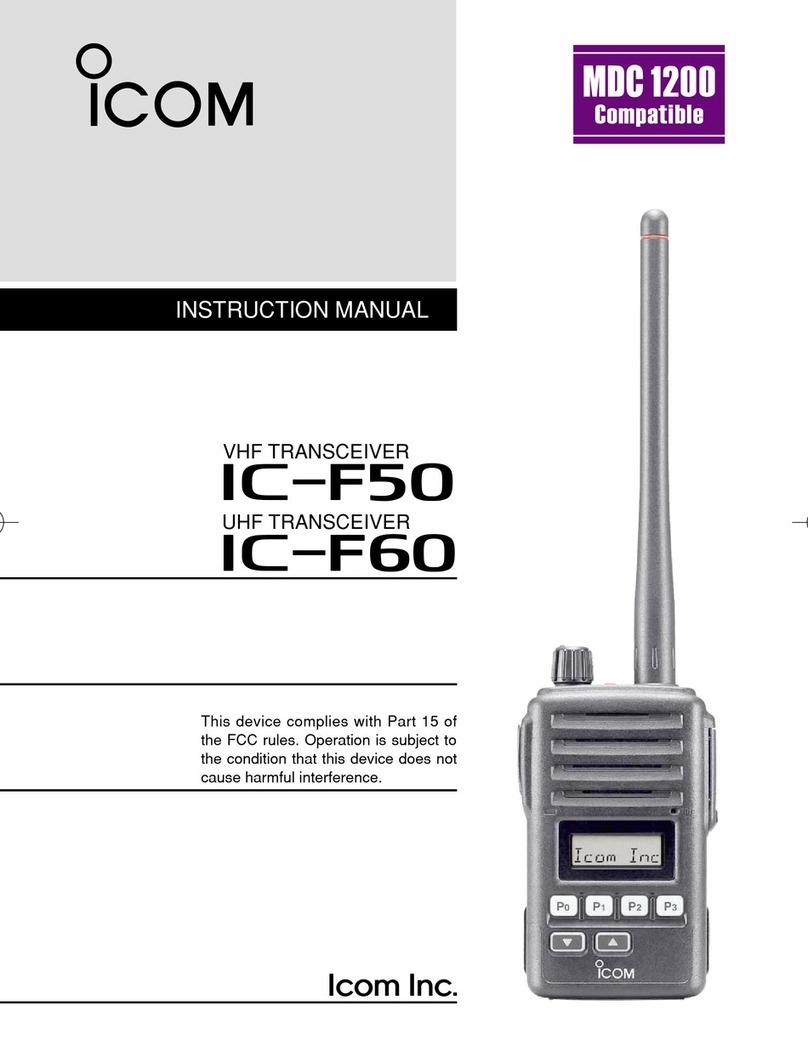
Icom
Icom VHF IC-F50 User manual
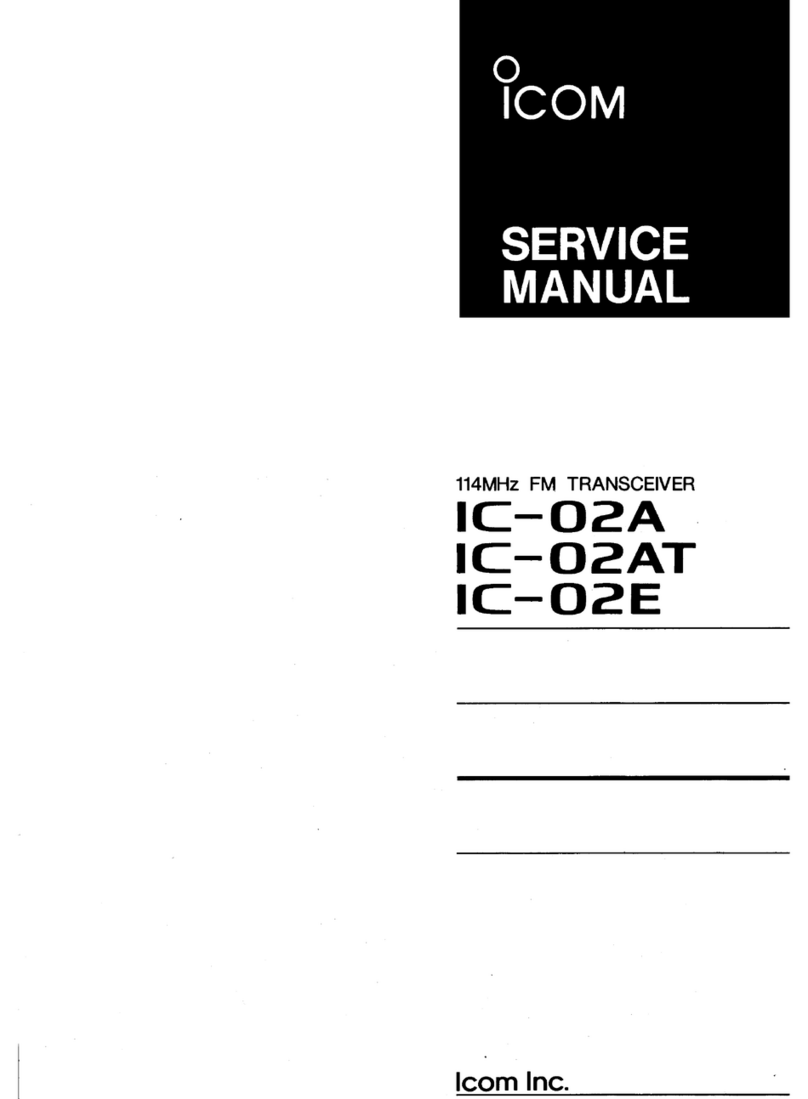
Icom
Icom IC-02A User manual
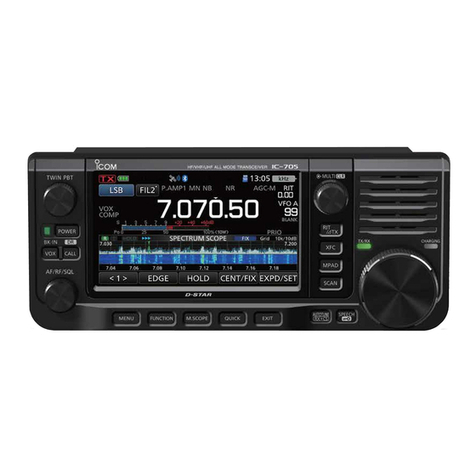
Icom
Icom IC-705 User manual
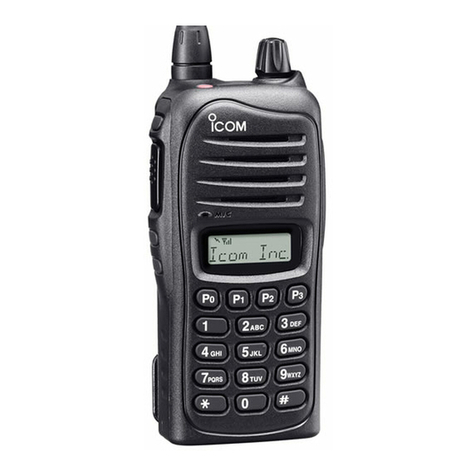
Icom
Icom IC-F3021T/S User manual
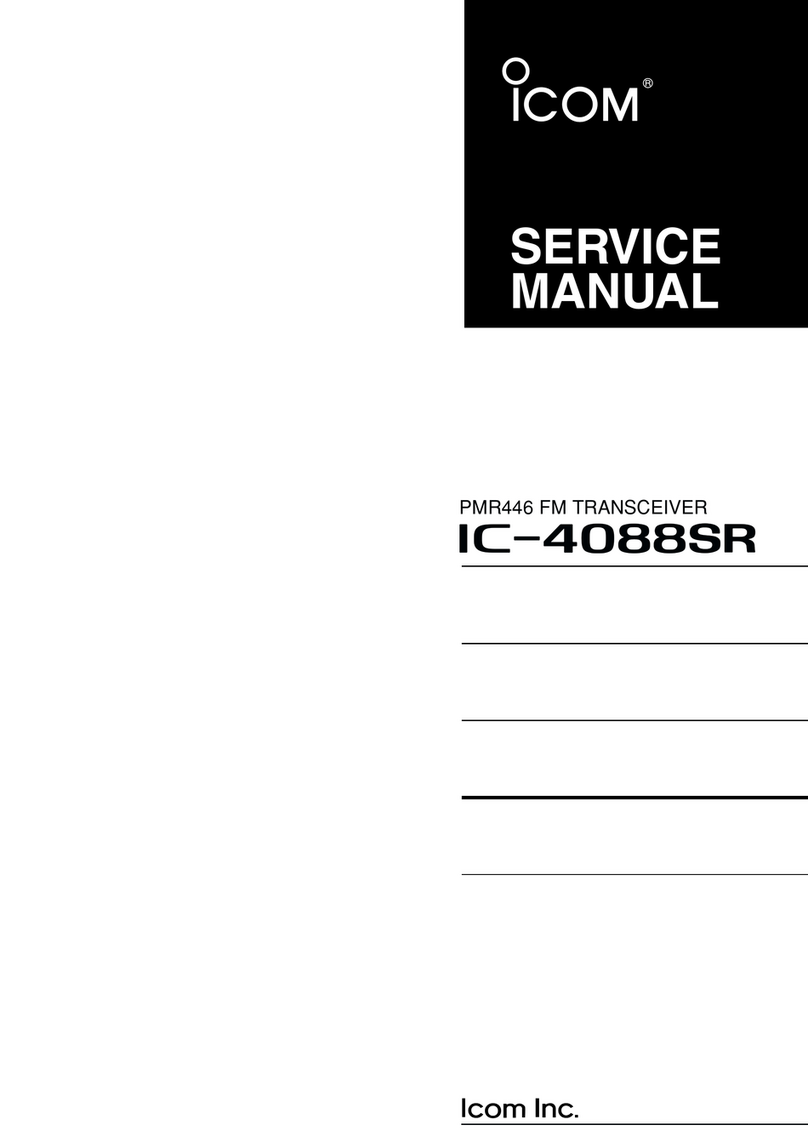
Icom
Icom IC-4088SR User manual
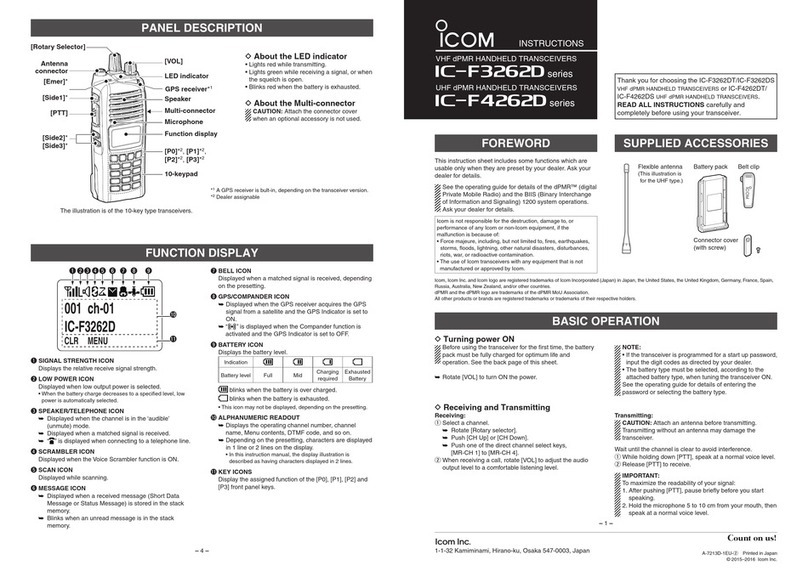
Icom
Icom IC-F3262D Series User manual
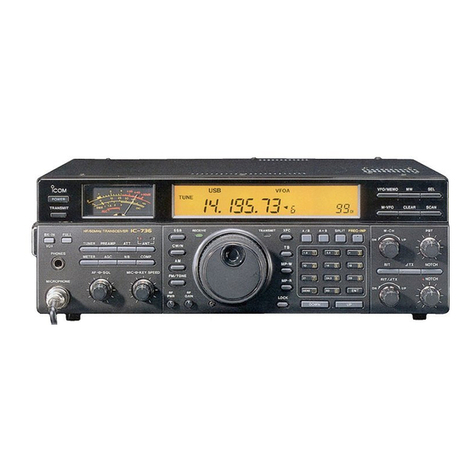
Icom
Icom IC-738 User manual

Icom
Icom IC-F1710 User manual

Icom
Icom IC-F29SDR Installation guide
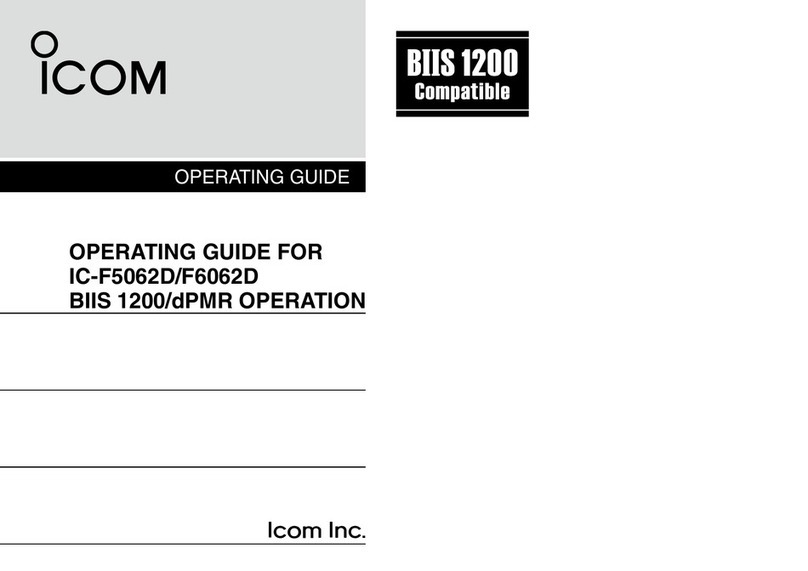
Icom
Icom IC-F6062D User manual

Icom
Icom IC-A14IC-A14S User manual
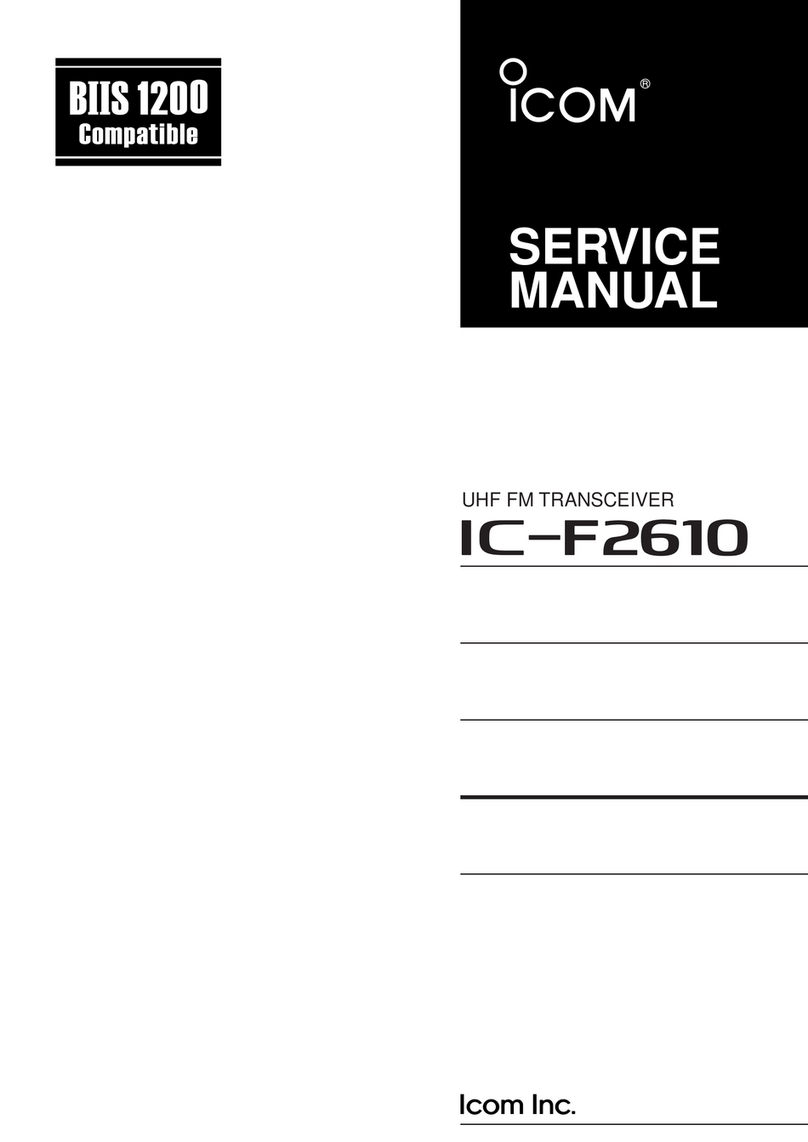
Icom
Icom IC-F2610 User manual
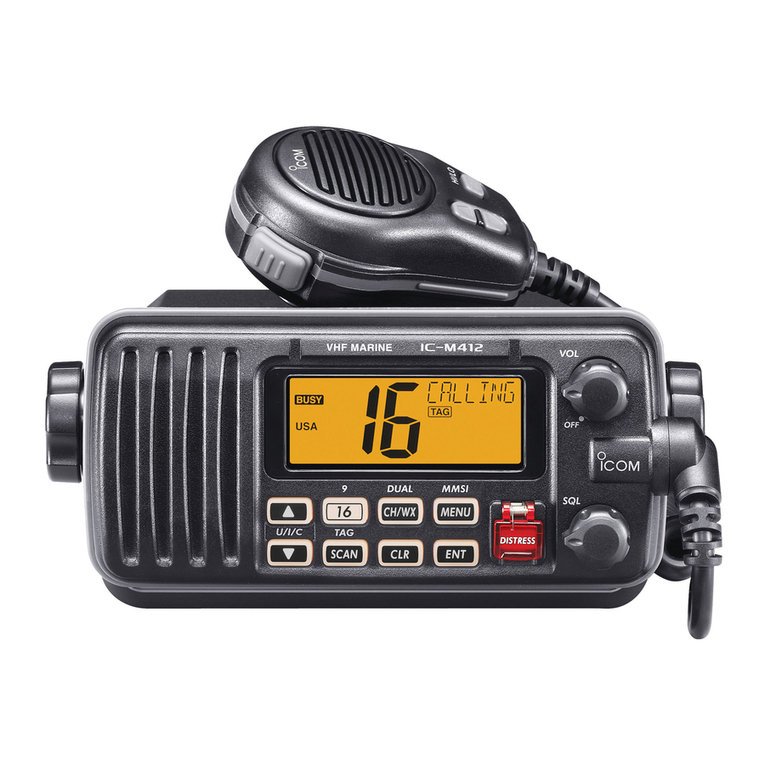
Icom
Icom IC-M412 User manual
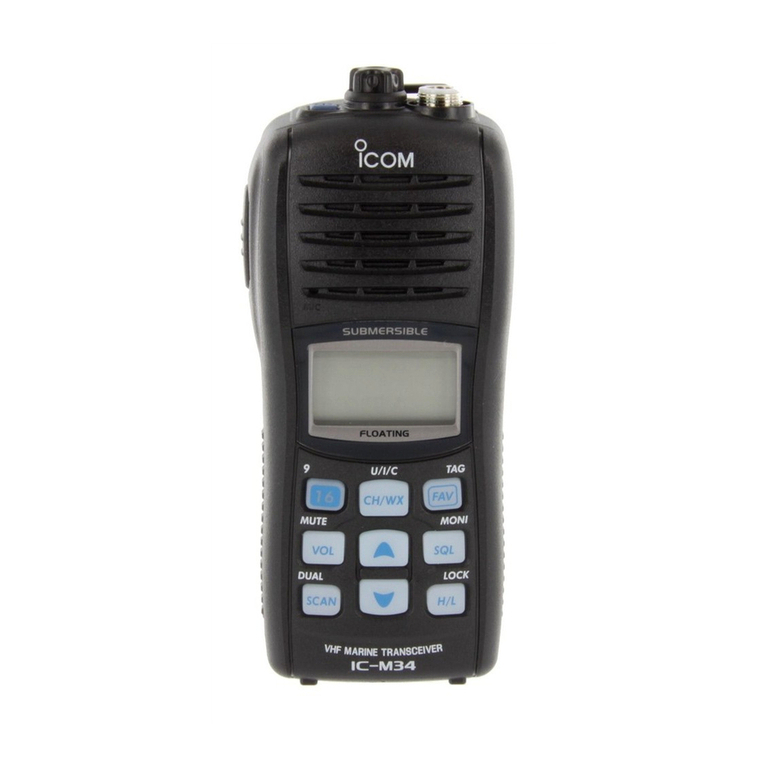
Icom
Icom IC-M34 User manual
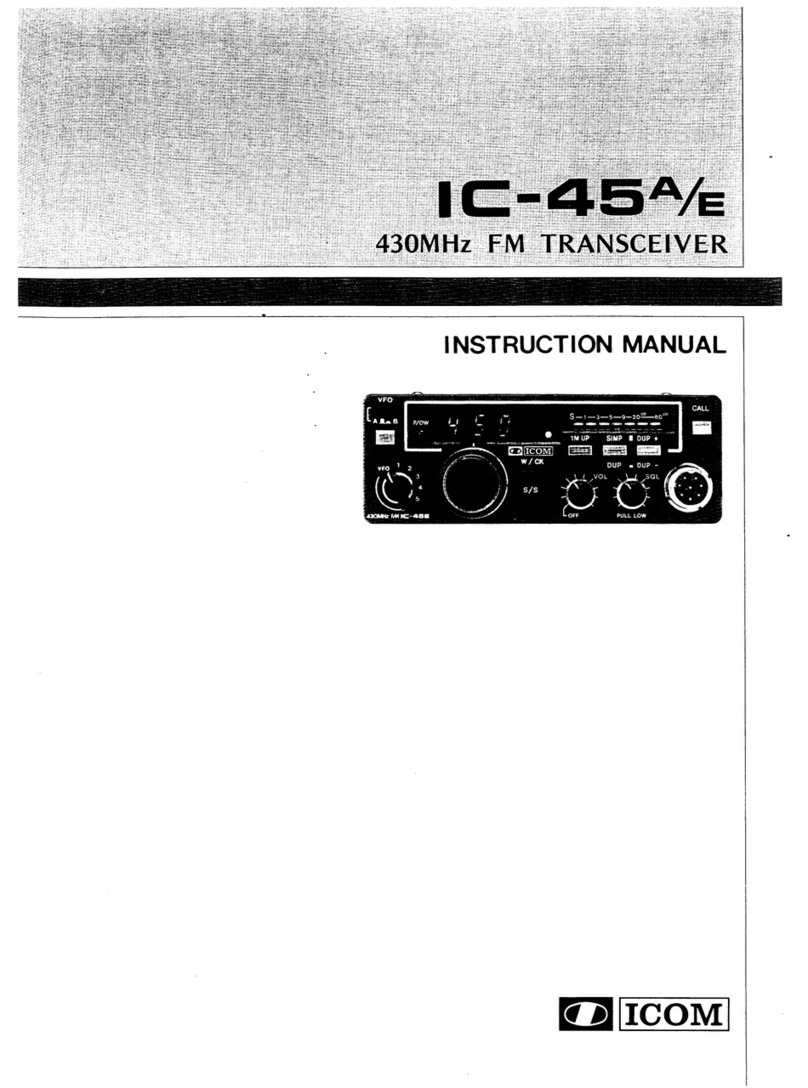
Icom
Icom IC-45A User manual
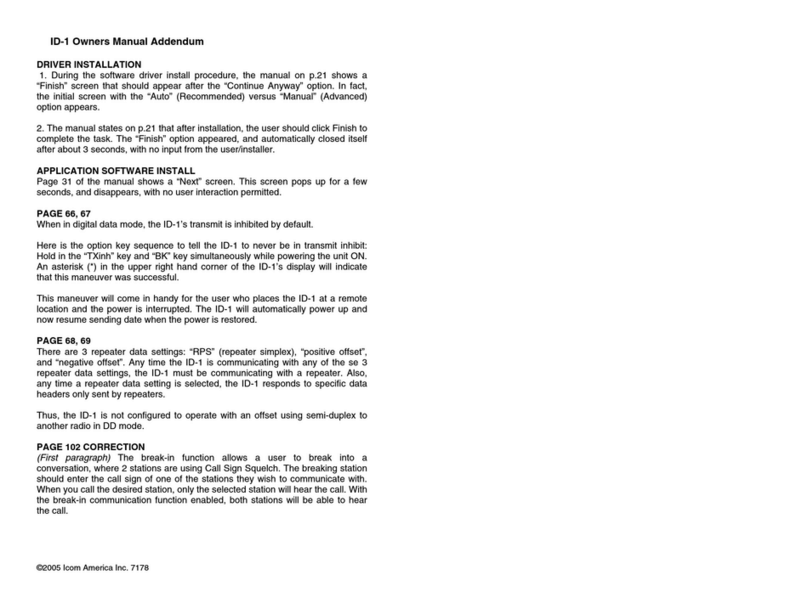
Icom
Icom ID-1 Installation and operating instructions
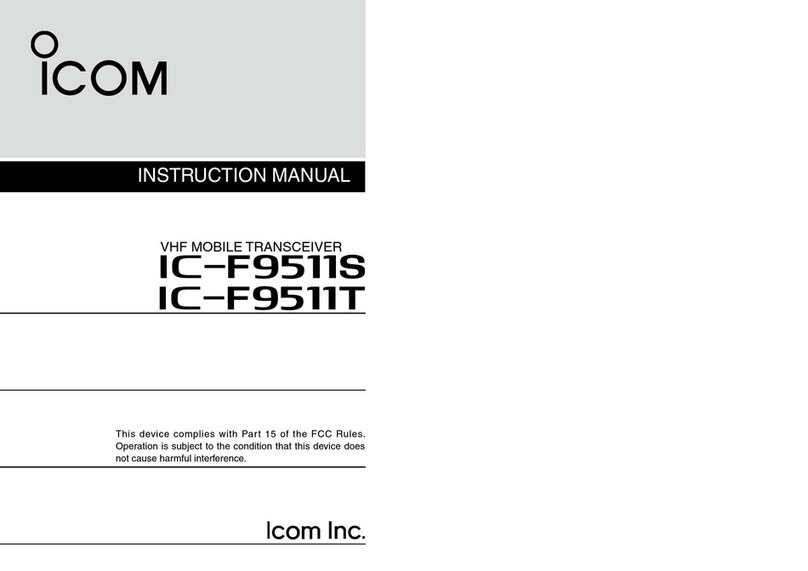
Icom
Icom IC-F9511S User manual
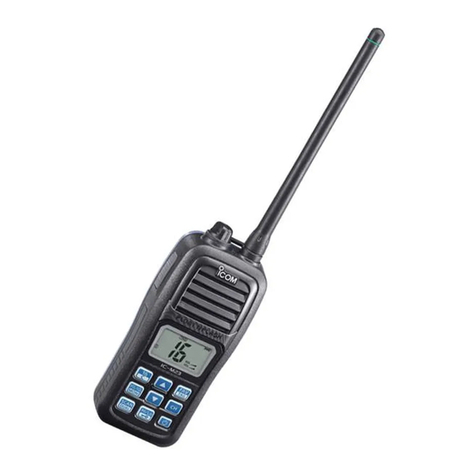
Icom
Icom IC-M23 User manual

Icom
Icom IC-U16 User manual
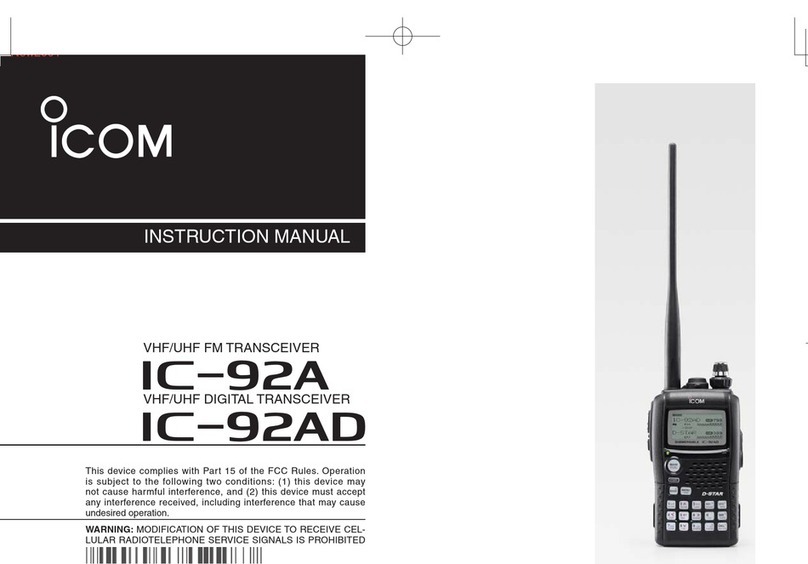
Icom
Icom IC-92A User manual

